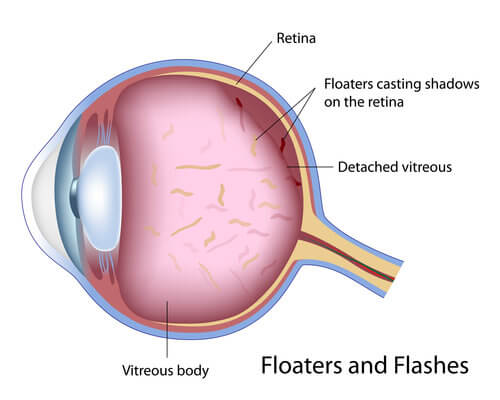Flashes & Floaters
The onset of flashing lights and floaters in the vision is one of the most common acute problems for eye care providers. Flashing lights often look like bright crescents in the periphery of your vision, or like a strobe light. Floaters appear as dark specks or curvy lines that move around your visual field and tend to be most noticeable in conditions with high illumination and high contrast (looking up at the blue sky). The symptoms of flashes and floaters can represent various eye problems, and a diagnosis can only be made with a thorough dilated eye examination.

In many cases, flashes and floaters represent a natural age-related change to the eye called a posterior vitreous detachment. The vitreous is a jelly-like material inside of the eye. At younger ages, the vitreous is attached to the retina (the wallpaper on the inside back of the eye), and it has a very uniform consistency. However, as we get older, the vitreous tends to break down and clump together in the center of the eye, and as it does, it often pulls away from the retina.
This is a posterior vitreous detachment. The floaters that you see are clumps of vitreous, and the flashing lights are a result of the vitreous attachments separating from the retina. In isolation, a posterior vitreous detachment is a natural part of the eye-getting older and does not represent a problem that needs treatment. Over time, the flashing lights go away, and the brain learns to ignore the vitreous floaters.
However, not every case of flashes and floaters represents a simple posterior vitreous detachment. These same symptoms could be a sign of a more serious condition, such as a retinal tear or a retinal detachment. In these cases, urgent treatment with a laser procedure or surgery is usually required.
If you are experiencing new flashing lights and new floaters, contact an eye care provider immediately. The doctors at New England Vision can always make room in their schedules to see you right away. Contact us to make an appointment.
Visit the American Academy of Ophthalmology’s EyeSmart® website to learn more about Flashes & Floaters.



